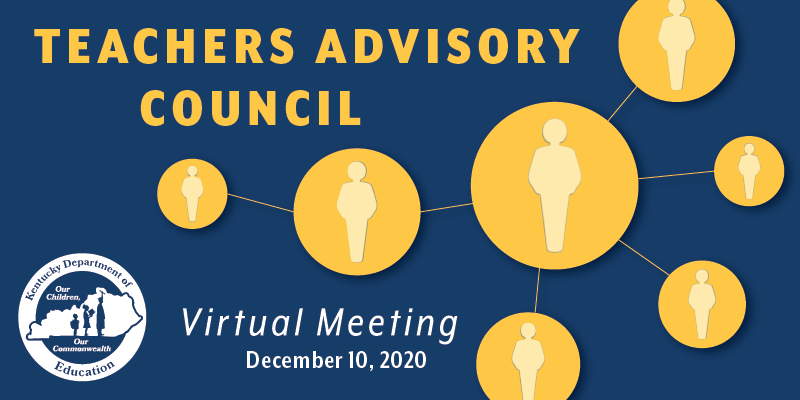 The Kentucky Department of Education’s (KDE’s) Teachers Advisory Council (TAC) provided feedback to Education Commissioner Jason E. Glass on a potential return to in-person instruction in January during its Dec. 10 virtual meeting.
The Kentucky Department of Education’s (KDE’s) Teachers Advisory Council (TAC) provided feedback to Education Commissioner Jason E. Glass on a potential return to in-person instruction in January during its Dec. 10 virtual meeting.
The meeting wraps up a week full of meetings where Glass also solicited feedback from the department’s Student Advisory Council, Principals Advisory Council and Parents Advisory Council.
Gov. Andy Beshear has asked the department to provide a recommendation on whether schools should return on Jan. 4, the date Beshear’s executive order suspending in-person instruction will expire, or continue virtual learning until a later date. Beshear had suspended in-person instruction in November amid high numbers of cases of COVID-19.
Glass plans to meet with Beshear on Dec. 11 to discuss the feedback received throughout the week from the advisory groups and to provide the department’s recommendation.
Ultimately, the decision will be made by Beshear, not by KDE or the Kentucky Board of Education, but the feedback received does factor into the department’s recommendation, Glass said.
“I’m not sure there is a right decision here,” he said. “ … What we have to do is make some tough choices and then live with the consequences associated with that choice.”
Glass said months from now, everyone will know how and when schools should have reopened, but the Commonwealth does not have the luxury of hindsight on its side.
Stephanie Beason, a representative from the 212° Academy (Warren County), said she believes that all teachers throughout Kentucky want to be back teaching their students in the classroom.
“We know that is where learning is most effective,” she said. “The question becomes: How do we do that safely?”
Prior to Beshear’s executive order, it was recommended that districts not open their school buildings to in-person learning if their county fell into the red zone for positive cases on the state’s COVID-19 incidence rate map.
The Warren County school district returned to in-person instruction, even when the county was in the red zone. The district implemented a hybrid model of instruction, where both virtual and in-person learning occurred.
When the executive order was signed, the district already had provided 43 instructional days through the hybrid model, Beason said.
“By and large, we are able to do that very safely,” she explained. “We had a very low transmission rate with students, teachers and staff.”
Warren County, like other areas of the state, currently is seeing spikes in positive cases. Beason recommends that the state provide districts with the flexibility to “decide what is best for their district.”
Though Warren County had success with the hybrid model of instruction, Beason said there was no discussion of bringing all students back together at the same time.
“We understand that that is not a viable option right now,” she said.
Another district that implemented a hybrid model of instruction when the county was in the red zone was Calloway County. The district is represented on the TAC by Noraa Ransey, who said the decision was the best choice for the district’s students.
“If you look at the numbers, we didn’t have kids getting sick, we didn’t have teachers getting sick,” she said, adding that even though she had to quarantine due to a close exposure to the virus, she did not regret the time she had in the classroom.
Being able to teach in person provided Ransey with the opportunity to get to know her 1st-grade students at North Calloway Elementary.
“They got to know me, they got to trust me and I would not trade that time for anything,” she said.
Ransey and other council members expressed concern with how far behind virtual learning has put students, dating back to the end of the 2019-2020 school year.
“They started the school year behind,” Ransey said. “We are not going to catch up this year.”
John Whipple, an 8th-grade social studies teacher at Breckinridge County Middle School, said that although schools are almost halfway through the academic calendar, students are not halfway through the content they need to learn.
Whipple said the state should start “thinking outside the box” by possibly extending the school year into the summer months to ensure students have learned all they need to.
“We should not finish in May,” he said. “We’re going to have to start looking at being able to pay people through June, July and August if we’re going to have our students get a quality year.”
Glass said that thinking about how districts can provide extended services and support to students is a great idea because Kentucky’s students are falling behind and the inequities that were present before the pandemic are now worse.
Equity in Education
Thomas Woods-Tucker, KDE chief equity officer and deputy commissioner for the department’s Office of Teaching and Learning, asked council members to discuss how their identity informs them as educators.
Quentin Johnson, an English teacher at Tates Creek High School (Fayette County), said his identity allows him to relate to his minority students.
As a Black man born in the Appalachian region and raised in Harlan County, Johnson said his identity allows him to reach an array of student subgroups.
Whipple said that for him, when you look at him “what you see is what you get.”
As a White man born in the 1960s, he said he has had to learn how to live in a diverse world he did not see growing up.
“For my minority students, I’m all they got,” he said, discussing the challenges he faces teaching his students about the history of Black people in the United States.
Ransey is one of only two minority teachers in her district and said that is not unique to Calloway County.
“Across this state, that is an issue,” she said. “You have a few sprinkled minority teachers, but we have a much higher population of minority students.”
While she said she would like to see more minority teachers in Kentucky classrooms, a focus should be placed on teaching all teachers how to better connect with their minority students.
Woods-Tucker said he doesn’t expect to see an equal balance between minority students and minority teachers soon, but the education community can do a much better job at being empathetic and connecting with all students.
“If equity is going to be at the forefront and if equity is going to be important in terms of what we’re doing, we need to have these tough conversations,” Woods-Tucker said.
The TAC also:
- Discussed supports KDE can provide to assist districts and schools with equity initiatives;
- Reviewed the Kentucky Academic Standards for World Language;
- Reviewed recommended changes to Kentucky’s accountability system. KDE’s Office of Assessment and Accountability will continue to solicit feedback on these changes before the Kentucky Board of Education takes action at its February regular meeting;
- Discussed supports GoTeachKY can provide to assist with school and district teacher recruitment and retention efforts; and
- Discussed how schools can use supplemental resources to maximize the effectiveness of remote teaching.




Leave A Comment